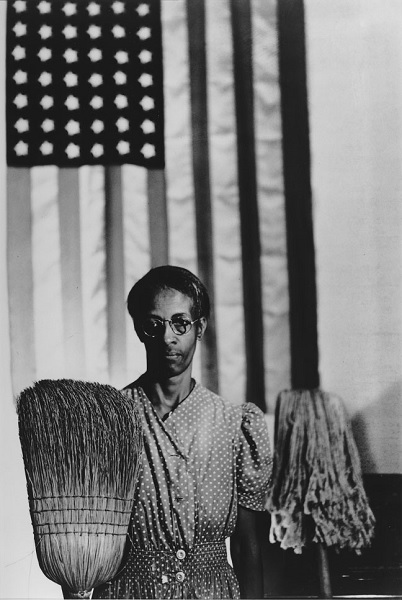
Gordon Parks
American, 1912-2006
Ella Watson, American Gothic, Washington, D.C., 1942, printed 1997
gelatin silver print
13 1/4 x 9 5/8 in.
SBMA, Gift of Arthur B. Steinman
2000.50.70

Photo credit diverseeducation.com/article/83248
"I saw that the camera could be a weapon against poverty, against racism, against all sorts of social wrongs. I knew at that point I had to have a camera." - Gordon Parks

Grant Wood - American Gothic
COMMENTS
As the 15th child of black Kansas sharecroppers, Gordon Parks knew poverty. But he didn’t experience virulent racism until he arrived in Washington in 1942 for a fellowship at the Farm Security Administration (FSA). Parks, who would go on to become the first African-American photographer at LIFE, was stunned. “White restaurants made me enter through the back door. White theaters wouldn’t even let me in the door,” he recalled. Refusing to be cowed, Parks searched out older African Americans to document how they dealt with such daily indignities and came across Ella Watson, who worked in the FSA’s building. She told him of her life of struggle, of a father murdered by a lynch mob, of a husband shot to death. He photographed Watson as she went about her day, culminating in his American Gothic, a clear parody of Grant Wood’s iconic 1930 oil painting. It served as an indictment of the treatment of African Americans by accentuating the inequality in “the land of the free” and came to symbolize life in pre-civil-rights America. “What the camera had to do was expose the evils of racism,” Parks later observed, “by showing the people who suffered most under it.”
http://100photos.time.com/photos/gordon-parks-american-gothic
SBMA CURATORIAL LABELS
A legendary and groundbreaking figure in 20th century American culture and society, Gordon Parks was a multifaceted artist who created work in photography, film, music, fiction, poetry, and memoir. Among the best-known of Parks’s photographs are those in which he depicted the people of his era with a searching humanity and formal power. This is apparent in his renowned portrait of Ella Watson, who was working in Washington, D.C. when Parks met her there in 1942 shortly after he was hired as a federal Farm Security Administration (FSA) photographer.
To create this iconic work, Parks pointedly placed Watson in a stance with props that echo Grant Wood’s "American Gothic" painting. The result is an arresting image that challenges the ideals of freedom, equality and opportunity that the distant US flag represents, and which have been denied to African Americans throughout U.S. history. Yet Watson is not merely a symbol: Parks gives her a presence and individuality that make the work a uniquely penetrating portrait in addition to being incisive social commentary. Parks would continue to photograph people this way throughout his career, creating many indelible images of the Civil Rights era, and of politicians, Hollywood stars, musicians, athletes, and cultural figures, both well-known and not.
Born in rural Kansas and spending his youth there and in Minnesota, places where opportunities for African Americans were limited at best, Parks forged an extraordinary career that took him across the globe. Like "American Gothic", the two smaller prints on display date from an early point in Parks’s professional life, but represent another aspect of his work. Stamps on the back of both indicate they were part of a World War II United States Navy project based on the fishing industry on the East Coast. This kind of reportage is like the work Parks would publish in the popular "Life" magazine, where, in an early personal milestone, he became Life’s first African-American photographer. Parks would later excel in shooting series that tackled racism, violence and poverty, while also providing the public enduring images of celebrity and popular culture. In 1954 the Santa Barbara Museum of Art presented a solo exhibition of Gordon Parks’s photographs, one of the artist’s early museum exhibitions, making the presence of these three works in the present exhibition particularly significant.
- Crosscurrents, 2018
